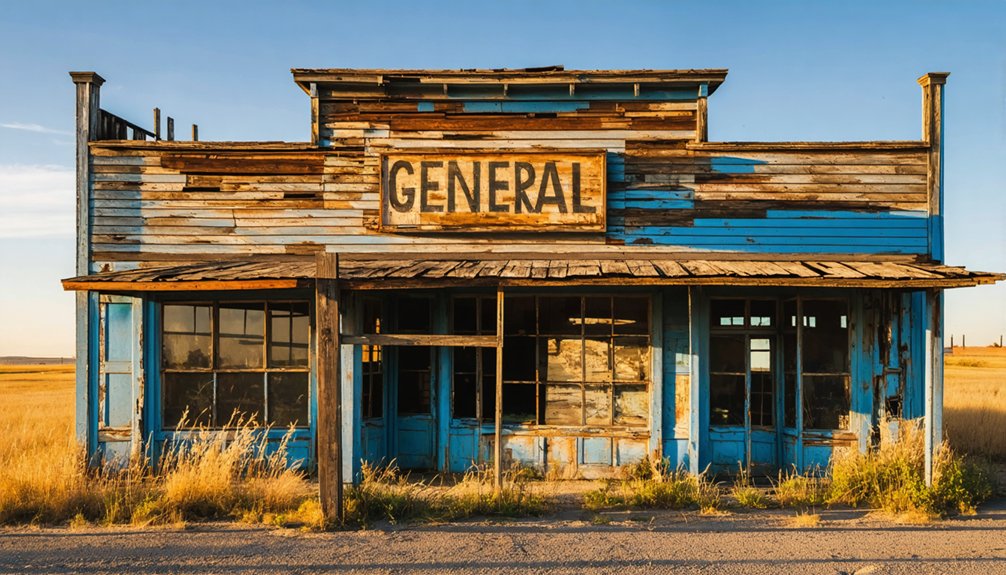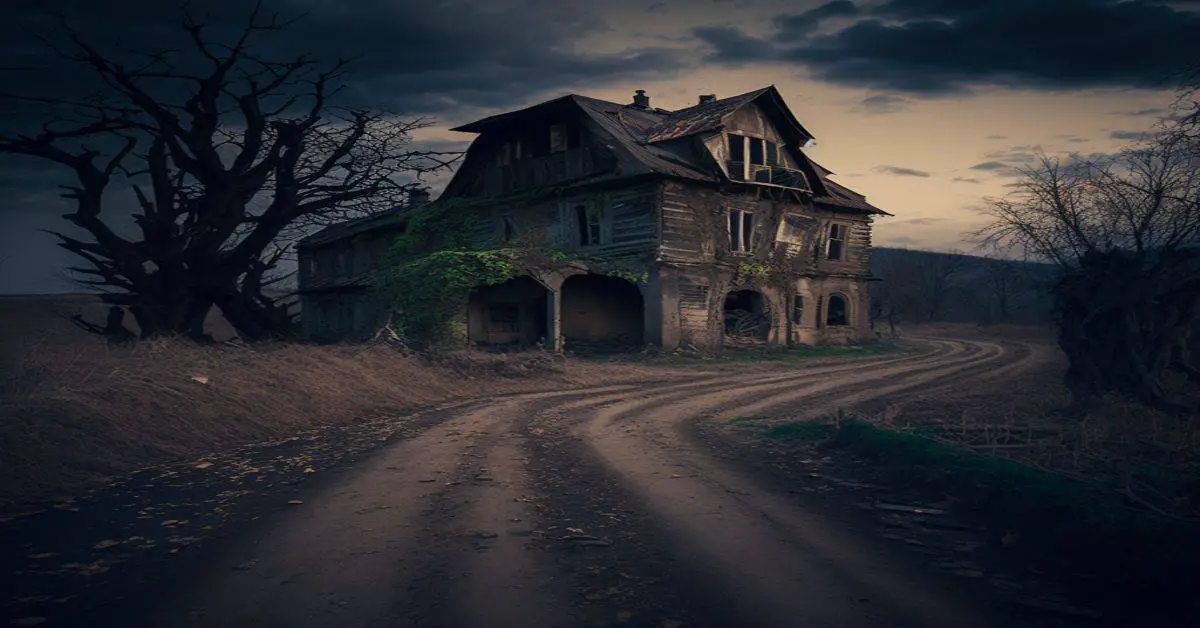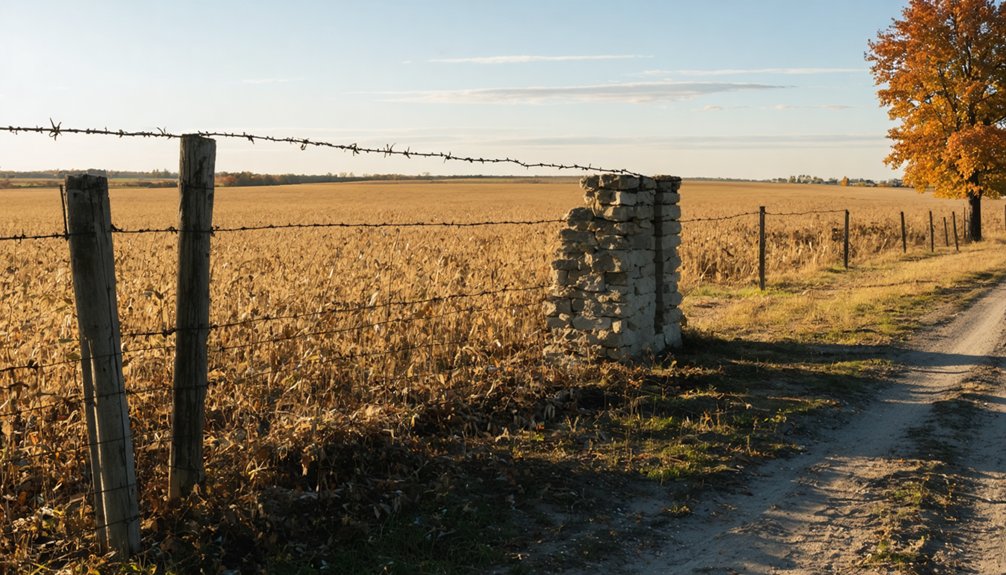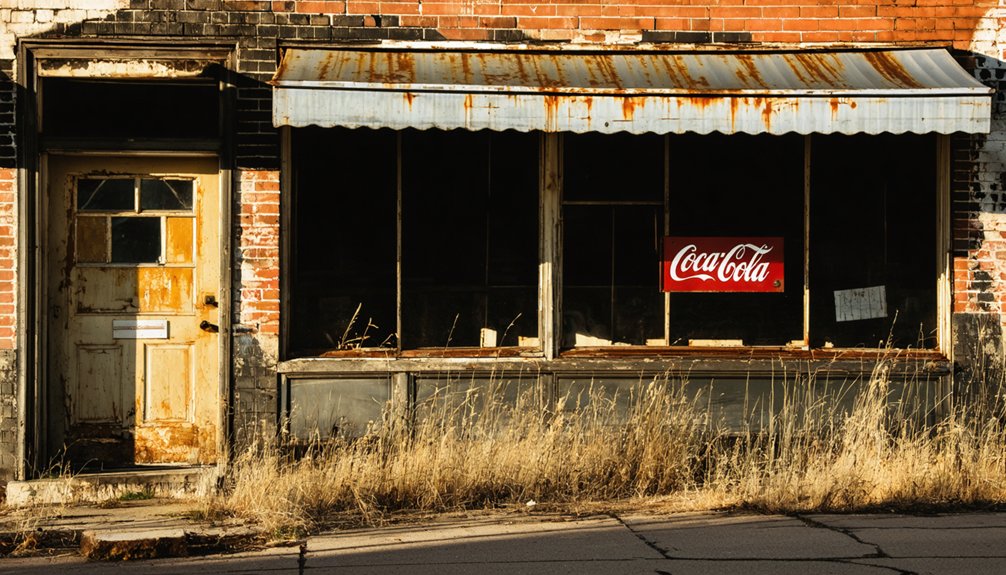You’ll find Oxford’s haunting ruins in rural Illinois, where a once-thriving 19th-century frontier settlement of 2,000 residents now stands abandoned. The town peaked during its agricultural heyday but declined when railroads bypassed it in the 1920s. The Great Depression dealt another blow, followed by devastating factory closures in the 1940s. Today, weathered churches, an old schoolhouse, and a general store tell stories of Oxford’s bustling past through their silent foundations and scattered artifacts.
Key Takeaways
- Oxford was once a thriving 19th-century rural settlement with 2,000 residents before declining due to railroad bypass and economic hardships.
- The town’s downfall accelerated during the Great Depression, with agricultural crisis and factory closures leading to significant population exodus.
- Major employers like Quaker Oats and Blommer Chocolate shut down operations, resulting in over 1,000 job losses in the community.
- Archaeological surveys have uncovered building foundations and artifacts from the late 19th and early 20th centuries throughout Oxford.
- The ghost town currently lacks formal preservation efforts or protected status, leaving historical structures vulnerable to further deterioration.
The Rise and Fall of Oxford’s Glory Days
While Oxford, Illinois began as a promising rural settlement in Henry County during the 19th century, its trajectory from growth to decline tells a story familiar to many Midwestern ghost towns.
The rise and fall of Oxford mirrors countless Midwestern towns that flourished briefly before fading into historical footnotes.
As a small township with roughly 2,000 residents at its peak, Oxford represented the typical rural community of its era.
You’d have found a vibrant agricultural community where farmers and merchants built their dreams, establishing general stores, schools, and churches that became centers for community gatherings and local traditions.
Like old coal mining towns, many families were forced to relocate in search of new employment opportunities.
But Oxford’s fortune wouldn’t last. When railroads bypassed the town in favor of other routes, its economic lifeline began to wither.
The lack of rail access meant fewer opportunities for trade and growth, while nearby towns with better transportation connections flourished.
As infrastructure declined and younger residents sought opportunities elsewhere, Oxford’s once-bustling streets gradually emptied, leaving behind only memories of its former prosperity.
Life in Early Oxford Settlement
Back when Oxford’s first settlers arrived in Henry County, you’d have witnessed the ambitious formation of a tight-knit frontier community shaped by Protestant values and agricultural pursuits.
Life revolved around three essential aspects:
- Daily agricultural practices that included crop cultivation, livestock management, and resource sharing among neighbors.
- Regular community gatherings at wooden structures serving as both church and meeting hall, where families strengthened their social bonds.
- Collaborative efforts in building infrastructure, from constructing log homes to developing primitive roads.
You’d find families working together, sharing tools, and supporting each other through environmental challenges. Much like the settlers of New Philadelphia, Oxford’s residents demonstrated remarkable resourcefulness in establishing their community.
Their Protestant faith guided social norms while fostering a spirit of cooperation.
Trading with nearby settlements helped establish economic stability, though most residents relied primarily on their own agricultural output for survival.
Mothers took on the responsibility of educating their children using fragments of old books while the fathers worked the fields.
Economic Forces Behind the Exodus
The decline of Oxford’s economic fortunes began with the railroad’s diminishing role in the 1920s, when you’d see fewer trains stopping at the once-bustling station that had previously connected the town to major trading routes.
The Great Depression accelerated the town’s decline as the agricultural crisis of the 1930s hit Oxford’s farming community particularly hard, as crop prices plummeted and many family farms faced foreclosure.
The final blow came in the late 1940s when Oxford’s downtown factories, unable to compete with larger urban manufacturers, shut their doors and left hundreds of workers unemployed. Like modern-day Decatur, the town experienced severe economic hardships as key industries closed their doors.
Railroad Development Impact
During the pivotal railroad expansion of the 1850s, Illinois Central Railroad’s decision to bypass Oxford proved catastrophic for the town’s future.
The railroad’s choice of a flatter, cheaper route west of Oxford reflected harsh railroad economics, prioritizing construction speed and cost efficiency over local interests. Illinois had ten railroads operating by this time, all serving Chicago’s growing network.
You’ll find the impact of this transportation infrastructure decision was swift and devastating:
- Local businesses couldn’t compete with rail-served towns, facing higher shipping costs and limited market access.
- Population and capital migrated to nearby communities with direct rail service.
- Oxford missed significant opportunities for industrial and commercial development.
Without rail spurs or loading facilities, Oxford’s isolation deepened as neighboring towns like Centralia and Chester flourished. By 1898, successful rail-served Illinois towns were generating annual earnings of $8,724,997 through established routes like the Chicago, Burlington & Quincy Railroad.
The town’s eventual decline into obscurity directly mirrored the rise of communities fortunate enough to secure their place along the steel rails.
Agricultural Market Shifts
As successive waves of farmland value fluctuations battered Illinois agriculture from the 1980s onward, Oxford’s remaining farmers faced mounting economic pressures that accelerated the town’s decline.
You’d have witnessed devastating farmland trends, starting with the 1982-1987 crisis when values plummeted 10% annually, followed by a brief recovery until 2003.
While 2004-2016 brought a temporary boom from ethanol demand, it wouldn’t last. By 2015, you’d see another 4.4% downturn as commodity prices fell and interest rates climbed.
The shift from diverse farming to corn-focused operations left Oxford’s farmers exposed to greater economic vulnerability. Recent federal assistance programs had helped stabilize some operations, but their effects proved temporary. Total operating expenses had ballooned to over $900 per acre by 2014.
When corn prices crashed after 2012, rising costs and declining income forced many families out, weakening the community’s agricultural foundation and business networks.
Factory Closures Downtown
While Oxford’s agricultural decline dealt the first blow to the town’s economy, massive factory closures in 2025 delivered the knockout punch to its downtown corridor.
You’d see the impact most clearly in three devastating waves:
- Quaker Oats’ shutdown eliminated 500 jobs, crushing the local workforce and sending shockwaves through downtown businesses.
- Blommer Chocolate’s closure followed, wiping out another 226 positions and further emptying the once-bustling streets.
- Rivian and Monterey Mushrooms soon followed suit, pushing total job losses beyond 1,000.
Despite community rebuilding efforts and proposed factory revitalization strategies, Illinois’ high taxes and strict regulations kept driving businesses away.
Notable Buildings and Landmarks
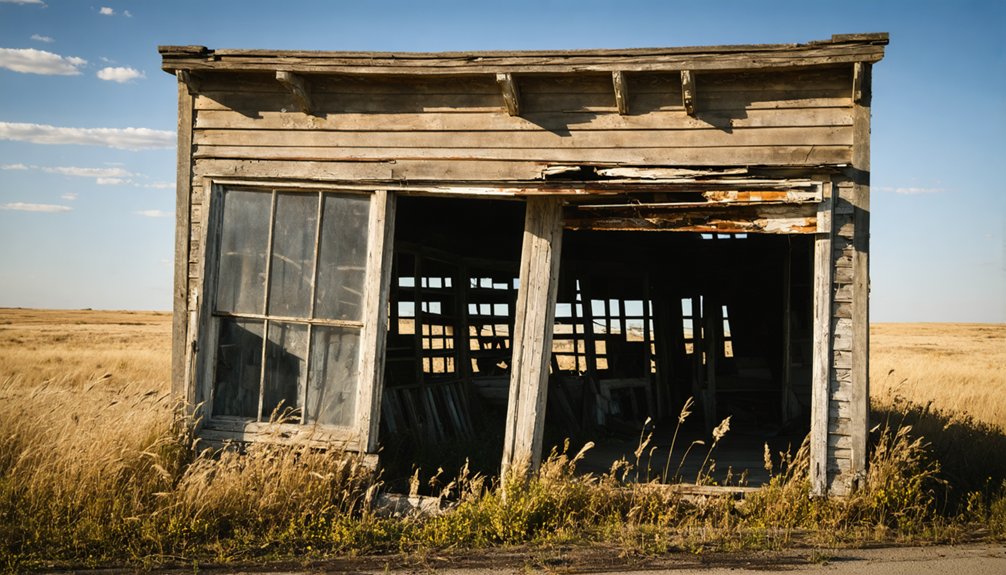
Despite its abandoned state, Oxford, Illinois retains several notable buildings and landmarks that tell the story of its once-thriving community.
You’ll find historical farmhouses scattered across the landscape, showcasing the ghost town architecture that defined this agricultural settlement. The town’s historical significance is evident in its late 19th-century churches and the weathered schoolhouse that once educated local children.
As you explore the area, you’ll discover the old general store and community center, both representations of Oxford’s bustling past.
The abandoned railway tracks and historic bridges connect different parts of the town, while the old cemetery offers glimpses into the lives of former residents.
Throughout the settlement, wooden and brick structures stand alongside rusting farm equipment, creating a haunting tableau of rural American history.
Stories From Former Residents
Through oral histories and recorded interviews, former residents of Oxford have painted a vivid picture of daily life in this once-thriving farming community. Their nostalgic tales reveal a close-knit society where community spirit flourished through seasonal festivals, church gatherings, and shared hardships.
- Residents describe children playing in the streets and exploring abandoned buildings as the town’s decline began.
- Families share memories of helping neighbors during tough times, particularly when local mines closed and the railroad was rerouted.
- Elders recount how social gatherings, from harvest festivals to school plays, defined their cultural identity.
You’ll find their stories consistently emphasize Oxford’s gradual transformation from a bustling agricultural center to a ghost town, as younger generations sought opportunities elsewhere and businesses slowly shuttered their doors.
Natural Disasters and Environmental Impact
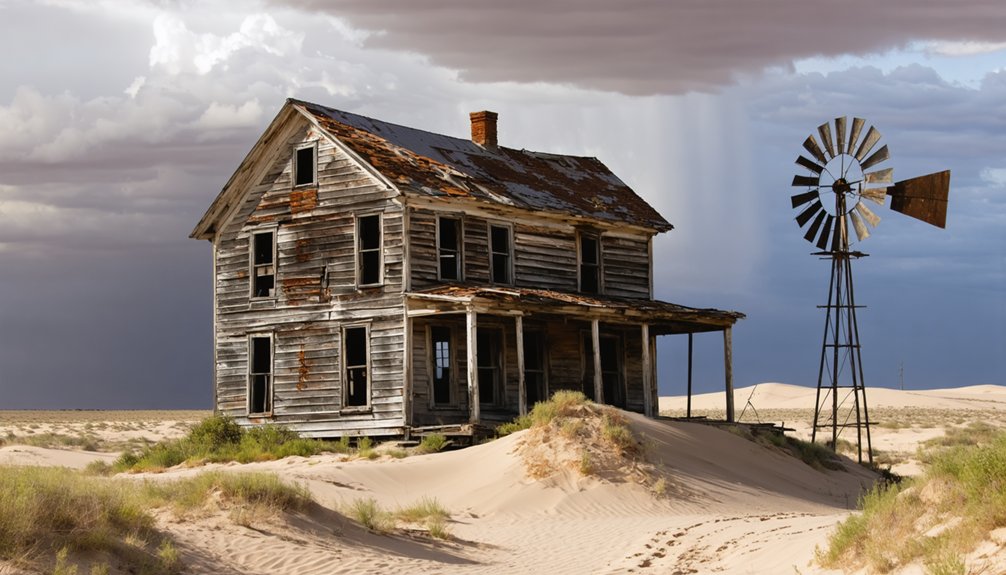
If you’d traveled through Oxford in its early days, you’d have witnessed how seasonal flooding from nearby waterways regularly threatened the settlement’s infrastructure and farmland.
The town’s location made it particularly vulnerable to spring floods that damaged homes and businesses, while also eroding valuable agricultural soil over time.
Weather patterns shifted dramatically through the decades, bringing more severe storms and flooding that ultimately contributed to Oxford’s declining population as residents sought safer ground elsewhere.
Floods and Settlement Impact
While Oxford’s specific flood history remains largely undocumented, the town’s fate parallels many Illinois settlements affected by recurring floods and environmental challenges.
You’ll find that flood resilience played a significant role in settlement sustainability, as communities along Illinois waterways often faced difficult choices about their future.
When examining the impact of floods on settlements like Oxford, you’ll discover three key patterns:
- Recurring floods reshape the physical landscape, affecting infrastructure and building stability.
- Environmental pressures combine with economic challenges to accelerate population decline.
- Communities without proper flood protection measures often struggle to maintain long-term viability.
These environmental pressures, particularly along river embankments, have contributed to the transformation of once-thriving settlements into ghost towns throughout Illinois.
Weather Patterns Over Time
As Oxford faced the extreme weather patterns of central Illinois, natural disasters and environmental challenges played a crucial role in its eventual abandonment.
You’ll find that tornado frequency was particularly high in this region, with destructive clusters occurring between the late 19th and early 20th centuries. Without modern warning systems, these storms proved especially devastating to the young settlement.
The area’s climate variability created additional hardships, as temperatures swung from scorching 90°F summers to frigid sub-zero winters.
You’d have witnessed powerful thunderstorms in spring and summer months, followed by periods of drought that stressed crops and weakened the town’s agricultural foundation.
These weather extremes accelerated the deterioration of buildings and infrastructure, while seasonal storms gradually eroded the soil and altered the landscape, ultimately hastening Oxford’s decline.
Archaeological Discoveries and Findings
Through systematic archaeological surveys of Oxford, Illinois, researchers have uncovered extensive material evidence of this once-thriving settlement. Using modern excavation techniques, they’ve revealed foundations of wooden and brick buildings, including a schoolhouse and commercial structures.
Artifact analysis has yielded a wealth of household items and trade goods dating to the late 19th and early 20th centuries.
- Recovered items include ceramics, glass bottles, metal tools, and personal effects that paint a picture of daily life.
- Foundation remains show evidence of flood damage and typical abandonment patterns seen in Midwestern ghost towns.
- Archaeological work continues under Illinois state protection laws, with permits issued by SHPO ensuring proper site management.
The findings help reconstruct Oxford’s layout, economic status, and the factors that led to its eventual abandonment.
Photography Guide to Oxford’s Ruins
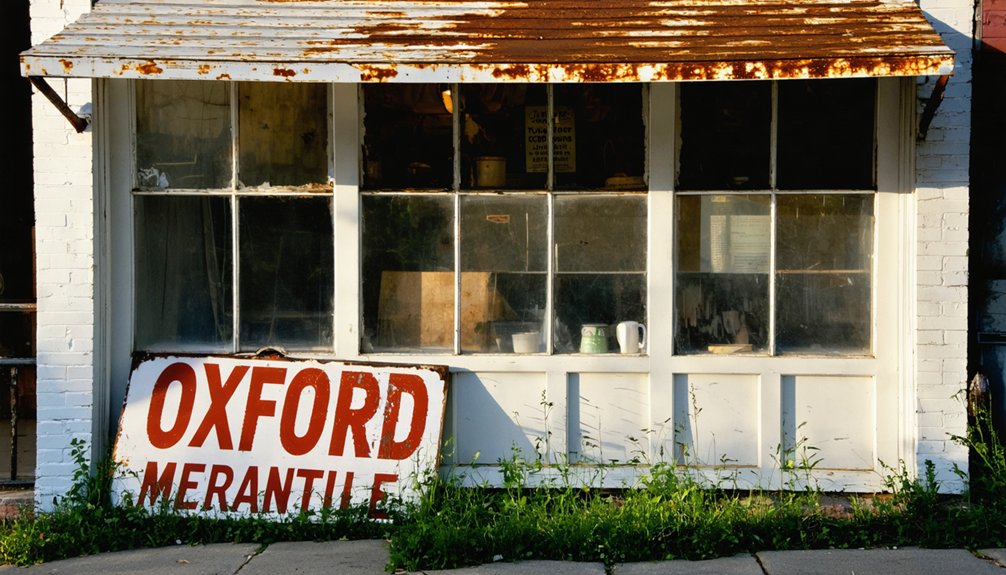
Modern photographers seeking to document Oxford’s ruins can build upon the archaeological evidence by capturing compelling visual records of this historic ghost town.
Through careful documentation and artistry, photographers can preserve Oxford’s ghostly remnants for future generations to study and appreciate.
You’ll need a quality camera with wide-angle and prime lenses, plus a sturdy tripod for stabilizing shots of abandoned structures in low light conditions.
For the best results, photograph during golden hours – early morning or late afternoon – when natural light enhances textures on weathered surfaces.
Inside buildings, use flashlights to illuminate dark corners while capturing architectural details.
Apply photography techniques like long exposures at dusk to create moody atmospheres, and experiment with black and white processing to emphasize contrast and timelessness.
Before shooting, obtain necessary permissions and respect site preservation rules.
Focus on telling Oxford’s story through both sweeping landscapes and intimate details of artifacts within the ruins.
Preservation Projects and Current Status
Despite its historical significance, Oxford currently lacks any formal preservation projects or protective status. You won’t find any active historical societies, preservation groups, or organized advocacy efforts working to protect the ghost town‘s remaining structures.
Three key challenges facing Oxford’s preservation include:
- No local or state organizations have designated the site as a preservation priority.
- There’s no documented infrastructure for heritage tourism, such as walking tours or interpretive signage.
- The absence of municipal planning documents or archaeological surveys leaves the ruins vulnerable.
Without community engagement or formal protection measures, Oxford’s historic remnants remain at risk.
The ghost town preservation situation mirrors many other abandoned Illinois settlements that lack dedicated resources and organized support for maintaining their cultural heritage.
Oxford’s Legacy in Illinois History
While Oxford’s physical remains continue to deteriorate without preservation efforts, its enduring legacy tells a broader story about Illinois’ development and the rise and fall of small farming communities.
You’ll find that Oxford’s history mirrors the challenges faced by numerous agricultural towns across the state, where economic diversification proved essential for survival.
Through community memories passed down through generations, Oxford serves as a powerful reminder of how reliance on a single industry can lead to decline.
The town’s story has become part of Illinois’ cultural revival efforts, helping modern communities understand the importance of adaptability and economic resilience.
Today, Oxford’s abandoned landmarks and documented history provide valuable lessons about sustainable community development and the delicate balance between tradition and progress.
Frequently Asked Questions
Are There Any Paranormal Activities Reported in Oxford’s Abandoned Buildings?
While you might expect ghost sightings in such an eerie setting, there’s no documented haunted history or verified paranormal activity in Oxford’s buildings. You won’t find any official reports or investigations here.
Can Visitors Legally Explore the Ghost Town Without Special Permits?
You’ll need to verify local exploration regulations before visiting, as some areas may be private property. Check current visitor guidelines with local authorities to guarantee you’re exploring legally.
What Items of Value Have Been Found by Metal Detectors?
Beneath the rust-colored soil, your treasure hunting efforts might uncover vintage coins, railroad spikes, farm tools, glass bottles, and historical artifacts like buttons and pocket knives from the late 1800s.
Are There Any Remaining Descendants of Oxford’s Original Settlers Nearby?
You’ll need to consult local genealogy records to verify settler descendants, though historical connections suggest some families likely remain in surrounding communities, especially in nearby Knox and Henry counties.
Does the Local Government Have Plans to Redevelop the Site?
Like seeds scattered in fallow fields, redevelopment plans are taking shape – you’ll find local government focusing on affordable housing, EV infrastructure, and historic preservation while carefully avoiding past ghost town pitfalls.
References
- https://illinoisstateonline.com/ghost-towns-in-illinois/
- https://drloihjournal.blogspot.com/p/lost-towns-of-illinois-series.html
- https://freepages.rootsweb.com/~gtusa/history/usa/il.htm
- http://ghosttowns.com/states/il/il.html
- https://en.wikipedia.org/wiki/List_of_ghost_towns_in_Illinois
- https://west-palm-beach-news.com/illinois-haunting-history-the-top-5-ghost-towns-revealed/
- http://www.genealogytrails.com/ill/earlysettlements.html
- https://www.touristsecrets.com/destinations/united-states/illinois/illinois-lost-settlement-secrets/
- https://mikeandjonpodcast.com/the-great-illinois-state-exodus-5-towns-residents-are-quickly-leaving-behind/
- https://toolack.com/abandoned-towns-in-illinois/
